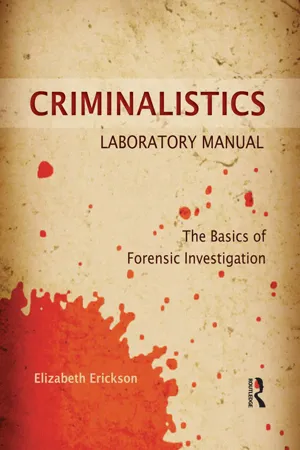
eBook - ePub
Criminalistics Laboratory Manual
The Basics of Forensic Investigation
Elizabeth Erickson
This is a test
- 226 Seiten
- English
- ePUB (handyfreundlich)
- Über iOS und Android verfügbar
eBook - ePub
Criminalistics Laboratory Manual
The Basics of Forensic Investigation
Elizabeth Erickson
Angaben zum Buch
Buchvorschau
Inhaltsverzeichnis
Quellenangaben
Über dieses Buch
The Criminalistics Laboratory Manual: The Basics of Forensic Investigation provides students with little to no prior knowledge of forensic science with a practical crime scene processing experience. The manual starts with an original crime scene narrative setting up the crime students are to solve. This narrative is picked up in each of the forensic science lab activities, tying each forensic discipline together to show the integrated workings of a real crime lab. After the completion of all of the exercises, the student will be able to solve the homicide based on forensic evidence.
Häufig gestellte Fragen
Wie kann ich mein Abo kündigen?
Gehe einfach zum Kontobereich in den Einstellungen und klicke auf „Abo kündigen“ – ganz einfach. Nachdem du gekündigt hast, bleibt deine Mitgliedschaft für den verbleibenden Abozeitraum, den du bereits bezahlt hast, aktiv. Mehr Informationen hier.
(Wie) Kann ich Bücher herunterladen?
Derzeit stehen all unsere auf Mobilgeräte reagierenden ePub-Bücher zum Download über die App zur Verfügung. Die meisten unserer PDFs stehen ebenfalls zum Download bereit; wir arbeiten daran, auch die übrigen PDFs zum Download anzubieten, bei denen dies aktuell noch nicht möglich ist. Weitere Informationen hier.
Welcher Unterschied besteht bei den Preisen zwischen den Aboplänen?
Mit beiden Aboplänen erhältst du vollen Zugang zur Bibliothek und allen Funktionen von Perlego. Die einzigen Unterschiede bestehen im Preis und dem Abozeitraum: Mit dem Jahresabo sparst du auf 12 Monate gerechnet im Vergleich zum Monatsabo rund 30 %.
Was ist Perlego?
Wir sind ein Online-Abodienst für Lehrbücher, bei dem du für weniger als den Preis eines einzelnen Buches pro Monat Zugang zu einer ganzen Online-Bibliothek erhältst. Mit über 1 Million Büchern zu über 1.000 verschiedenen Themen haben wir bestimmt alles, was du brauchst! Weitere Informationen hier.
Unterstützt Perlego Text-zu-Sprache?
Achte auf das Symbol zum Vorlesen in deinem nächsten Buch, um zu sehen, ob du es dir auch anhören kannst. Bei diesem Tool wird dir Text laut vorgelesen, wobei der Text beim Vorlesen auch grafisch hervorgehoben wird. Du kannst das Vorlesen jederzeit anhalten, beschleunigen und verlangsamen. Weitere Informationen hier.
Ist Criminalistics Laboratory Manual als Online-PDF/ePub verfügbar?
Ja, du hast Zugang zu Criminalistics Laboratory Manual von Elizabeth Erickson im PDF- und/oder ePub-Format sowie zu anderen beliebten Büchern aus Law & Criminal Law. Aus unserem Katalog stehen dir über 1 Million Bücher zur Verfügung.
Information
1
Laboratory #1 The Crime Scene Sketch
Chapter Outline
- 1.1 Crime Scene Sketches
- 1.2 Laboratory Exercise: Crime Scene Sketch
Learning Objectives
- Explain the various types of sketches
- Complete a rough sketch
- Complete a final sketch
- Demonstrate measurements within a crime scene
- Measure evidence using triangulation
What you will Learn
Laboratory #1, The Crime Scene Sketch, introduces the student to the various search techniques used for processing different types of scenes, such as indoor venues versus outdoor venues. The search techniques are explained with examples and suggestions for when to use one search technique over another. The use of triangulation is explained to measure evidence within a scene, which is also used for the laboratory exercise. Required information for a crime scene sketch is included with information on standard and military time conversions. The chapter ends with a laboratory exercise to show proficiency with creating a rough and final indoor crime scene sketch.
Key Terms
- demonstrative evidence
- elevation sketch
- enlarged sketch
- exploded sketch
- final sketch
- location sketch
- overview sketch
- rough sketch
Case File: 00-123456
After Officers Brown and O’Donnell realized that a double homicide had occurred, detectives, crime scene technicians, and the medical examiner were contacted for further processing of the scene. When the detectives arrived, the entire scene was cordoned off to prevent unnecessary people from entering and exiting in the hopes of preventing contamination. The detectives began to work on assessing the circumstances of the case and recreating the events that led to two deaths by interviewing witnesses, including Lynette Saunders.
While the detectives interviewed witnesses, the crime scene technicians and the medical examiner arrived to collect evidence from the scene. The crime scene technicians began to search the scene to locate possible evidence related to the homicide. The technicians located multiple pieces of evidence and placed yellow photo markers next to each item for future photographs, measurements, and finally collection.
The medical examiner checked each body and made observations about the location of each body and noted any outward signs that could assist with time of death determinations, such as rigor, livor, and algor mortis. Once the evidence was photographed around the body, the medical examiner took possession of the body for transport to the morgue.
Evidence Found at the Scene
The crime scene technicians found the following evidence at the crime scene:
- Multiple fingerprints located around the house and in the master bedroom
- Footwear impressions in blood located in the master bedroom and upstairs hallway
- Footwear impressions located outside the rear entrance to the Ashley residence
- Tool mark impressions on the outside of the rear entrance to the Ashley residence
- Red stains presumed to be blood located on the outside front stoop of the Ashley residence
- One blank pad of paper recovered from the kitchen counter
- Cigarette butts found outside at the rear of the Ashley residence
- One crowbar recovered from the master bedroom
- Two cartridge casings recovered from the master bedroom floor near William Ashley
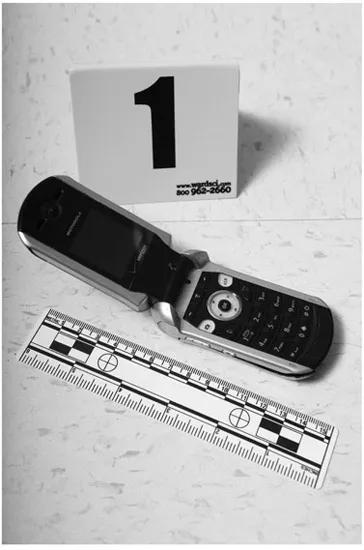
Cell phone found at the scene.
- Three cartridge casings recovered from the master bedroom floor near the foot of the bed
- Multiple hairs and fibers recovered from locations throughout the master bedroom
- Small piece of glass recovered from the master bedroom carpet
- Glass fragments located in the back hallway of the Ashley residence
- Small plastic bag containing a white powdery substance found on the front hallway floor
- Three empty pill bottles found on the upstairs hallway floor
- One pill bottle containing eight small blue tablets located outside in the bushes of the Ashley residence
- One diamond ring located outside on the ground
- One American Express card located outside on the ground
- One pair of black sunglasses located on the kitchen floor of the Ashley residence
- One cell phone located in the front hallway

Cartridge casings.
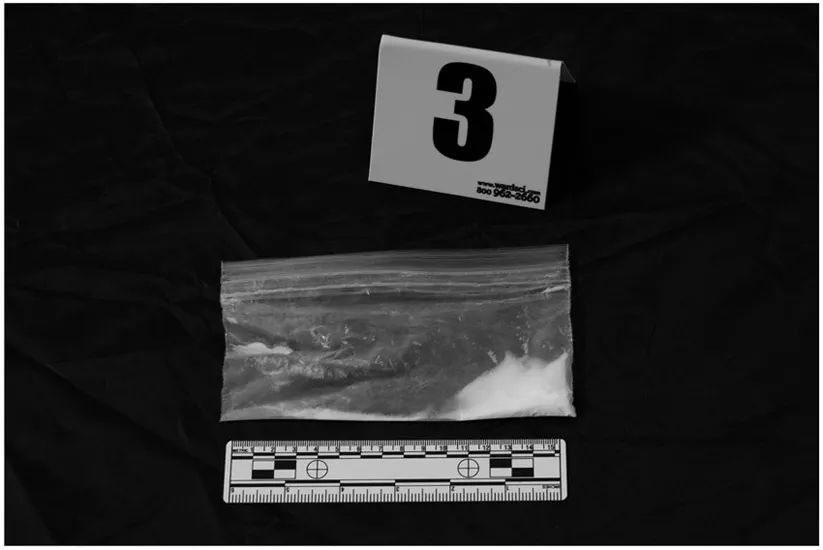
Small plastic bag containing white powder.
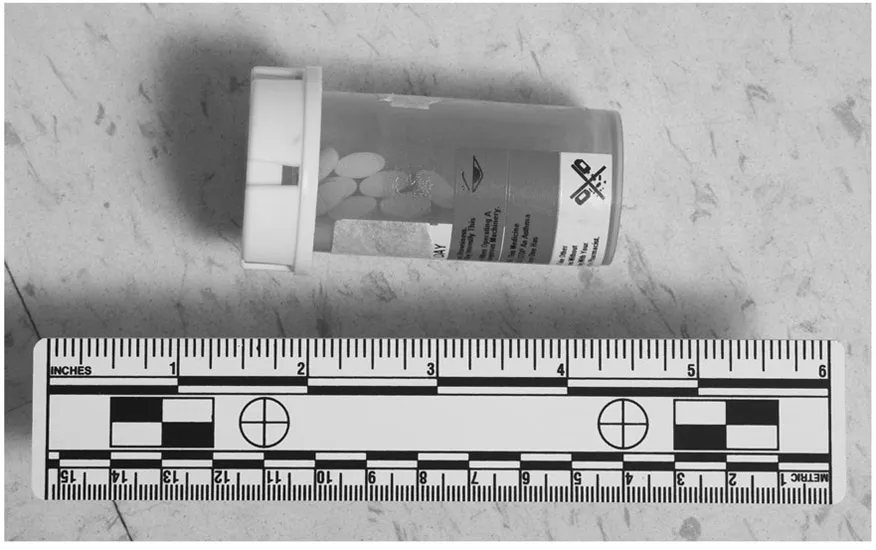
Pill bottle.
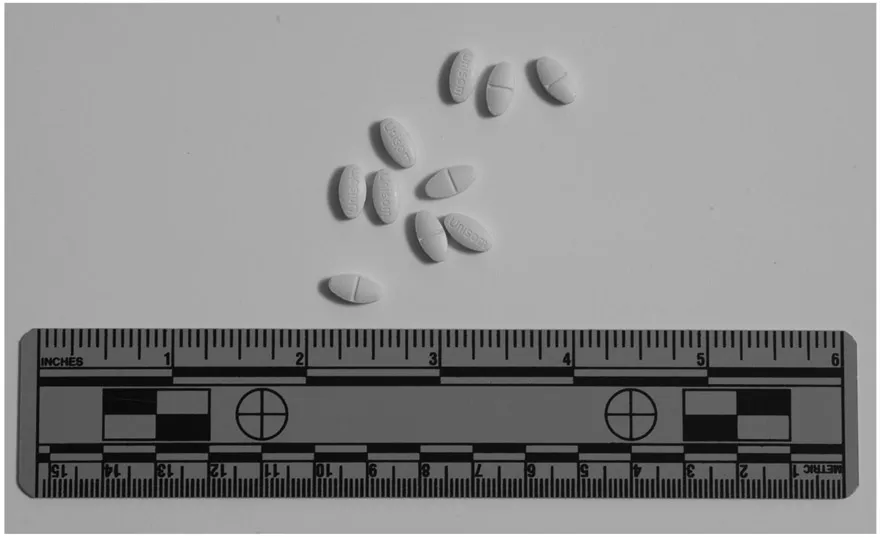
Pills.
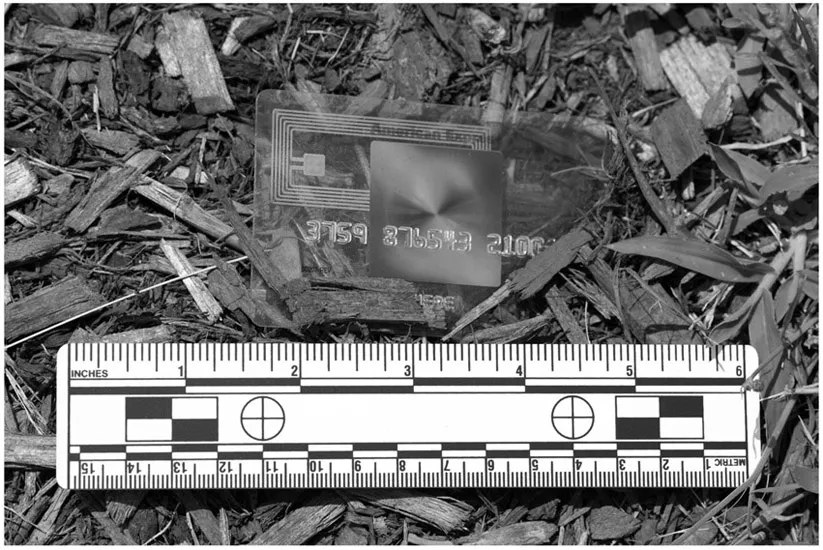
American Express card.
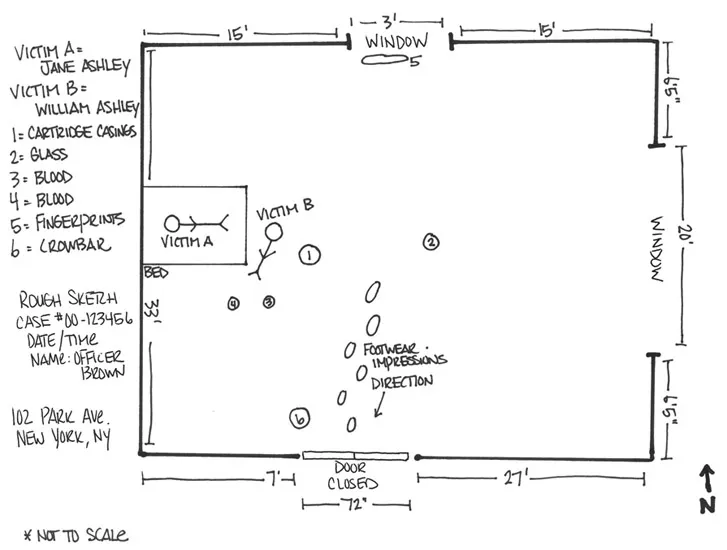
Sketch of where the bodies were located.
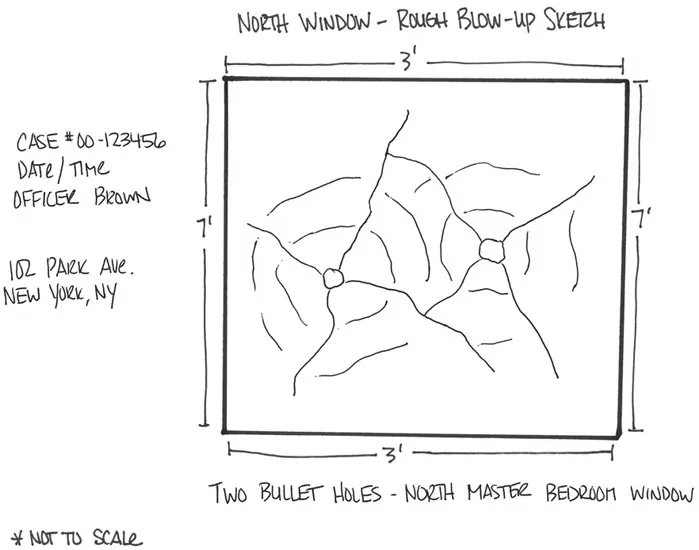
North window: Blown-up sketch.
1.1
Crime Scene Sketches
At major crime scenes, including homicides, a crime scene sketch must be made to accompany the pictures and the incident report describing the scene. The sketch is typically drawn by one of the technicians, but with recent technological advances, some departments have the capability of using crime scene sketching software to create a more realistic diagram for court presentation. Depending on the type of scene, multiple sketches would be completed to depict the entire area, specific locations with the body and/or evidence, location of events, etc.
Investigative Tip
A word processing program can be used to draw the basic perimeter of the c...
Inhaltsverzeichnis
Zitierstile für Criminalistics Laboratory Manual
APA 6 Citation
Erickson, E. (2013). Criminalistics Laboratory Manual (1st ed.). Taylor and Francis. Retrieved from https://www.perlego.com/book/1558772/criminalistics-laboratory-manual-the-basics-of-forensic-investigation-pdf (Original work published 2013)
Chicago Citation
Erickson, Elizabeth. (2013) 2013. Criminalistics Laboratory Manual. 1st ed. Taylor and Francis. https://www.perlego.com/book/1558772/criminalistics-laboratory-manual-the-basics-of-forensic-investigation-pdf.
Harvard Citation
Erickson, E. (2013) Criminalistics Laboratory Manual. 1st edn. Taylor and Francis. Available at: https://www.perlego.com/book/1558772/criminalistics-laboratory-manual-the-basics-of-forensic-investigation-pdf (Accessed: 14 October 2022).
MLA 7 Citation
Erickson, Elizabeth. Criminalistics Laboratory Manual. 1st ed. Taylor and Francis, 2013. Web. 14 Oct. 2022.